As I start accumulating posts, they will inevitably sort themselves out into various categories based on content. For everything else, there’s The Side Panel, a collection of random rants and ruminations and musings and mutterings on minutiae.
For this first official appearance of The Side Panel (not to be confused with my earlier piece on The Number 18, which is unofficially the first, perhaps the zeroth), I’ll be looking at this feature’s namesake, the often overlooked side panels in modern high-tech jerseys. If talk about armpits is your thing, um, welcome. Or not. Anyway…
Baseball uniforms have come a long way from the heavy flannel uniforms of the sport’s early years. As competition got tougher with more fans and more revenue, teams looked for every possible advantage the rulebook allowed (and a few it didn’t). In the days of synthetic material, changing the uniform has provided a way to both improve performance on the field and attract the attention of fans, now more likely to watch on television (either the physical box or the feed streamed over the internet) than in person. The modern baseball uniform is made as much to appeal to fans as it is to the player who wears it, so the ideal uniform is colorful, stylish, comfortable, and able to handle dirt, sweat, and the occasional fastball.
The big trend in uniforms over the past decade has been the introduction of Cool Base materials. The Cool Base jersey uses multiple different types of fabric to presumably perform different functions appropriate to the location of the material. Look, I’m no fashion expert, I’m just guessing here. It can’t be a coincidence though that the areas most likely to see lots of moisture are made of a different material than the rest of the jersey. And having panels of different materials makes it easy to mix different colors on a jersey, resulting in the common color patterns that have been seen on countless batting practice and special event uniforms.
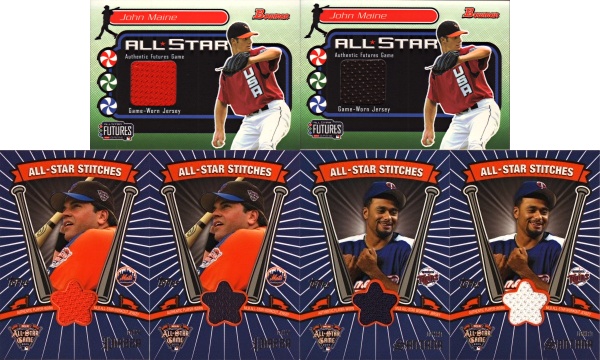
Futures Game and All-Star Jersey Variants
When you add in the inclusion of jersey swatches in baseball cards, these side panels, sometimes differently colored, sometimes not, introduce possible variants among the boring sameness that plagues today’s game-used offerings. These variants were first sighted in quantity in the 2005 All-Star workout jersey swatches featured in 2005 Topps Updates and Highlights (the 2003 All-Star and Futures Game jerseys featured a smaller secondary material section around the sleeves, but pieces of this are hard to come by). While the main colors of orange for the NL team and blue for the AL team were common, blue NL and white AL jersey swatches were occasionally seen. These were pieces from the jersey’s side panels and this was the start of a trend that would continue through All-Star, Futures Game, WBC, and regular MLB jerseys in years to come.
So does anyone care about these “rare” variants? Not really. I’m pretty sure it’s just me. Looking at the prices I’ve paid for the variants vs. the normal versions, there’s really no premium based on material type/color (though the same is true for most serial-numbered parallels, so it could just be that the market is generally indifferent towards things that aren’t sufficiently different). I like some variety in my collection though, so I set out to get as many of these variants as I can find. And so can you! Here are some helpful hints to get you started.
Know the Game
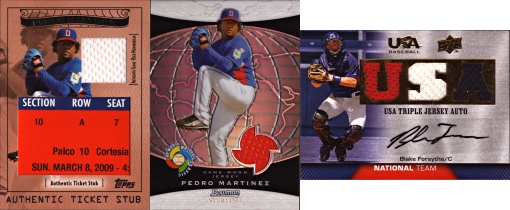
Pedro Martinez WBC jersey ariants and Blake Forsythe Team USA jersey variants
Baseball uniforms today come from a variety of sources. In addition to regular season MLB games, spring training games, the annual All-Star event (with its associated Futures Game), minor league games, the World Baseball Classic, Team USA, and various other random events produce jerseys that could make it into cards. Identifying the sources is the first step toward finding variants.
Know the Uniforms
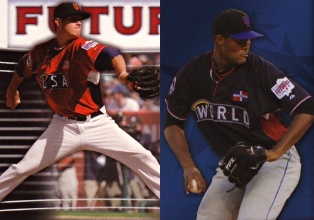
2010 Futures Game jersey photos with all three colors visible
The colors of the uniforms themselves will often provide clues about the source of the materials in cards. Knowing the colors of the uniforms in question will help to determine whether variants are commonly available and will let you know when to stop looking for more. It can take years to find some of these variants, so knowing what you’re looking for is essential.
Know the Materials
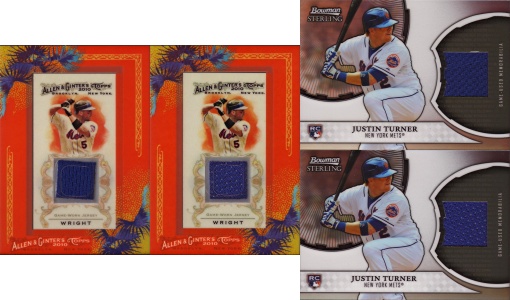
Not all variants are conveniently color-coded. For the Mets blue Cool Base jerseys (I’m guessing these are batting practice and/or spring training jerseys), the side panels are the same color as the main body of the jersey. How are you supposed to spot them from the tiny out-of-focus pictures people post on eBay? The simple way is to look for white or otherwise lighter colored spots in a regular pattern in the jersey swatch. Mesh side panels have holes in them, so the card’s backing will show through from certain angles.
Know the Products
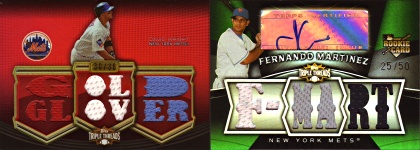
The most obvious products to search for jersey variants are the annual Topps Update and whatever Bowman product gets Futures Game jerseys. Other fall releases are also good places to look, primarily Topps Triple Threads. It is common to find Triple Threads triple jersey cards with two or three of the different color variants from a special event jersey.
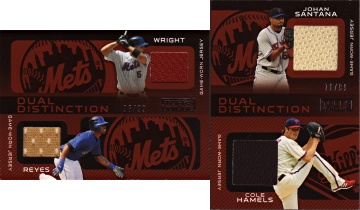
One-off products like 2009 Topps Unique and 2009 Topps Ticket to Stardom are also a common landing spot for whatever extra material Topps finds laying around from the last decade or so. Above are pieces from a Jose Reyes 2002 Futures Game jersey, a David Wright 2004 Futures Game jersey, and a side panel from a Johan Santana 2007 All-Star workout jersey.
Know the Players
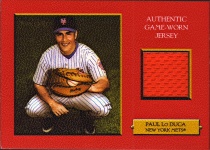
Sometimes, interesting pieces can show up in strange places. When Topps took over distribution of All-Star workout jersey material in 2004 (starting with pieces from the 2003 All-Star event), their All-Star Stitches insert set became the default home for everything All-Star. Swatches from various 2003 All-Star workout jerseys appeared elsewhere in 2004, but Topps has since managed to corral at least the first use of just about every jersey into what is now the premier game-used insert set in the annual update product. There are exceptions though, so it pays to know who was at the All-Star event but didn’t make it into All-Star Stitches, as was the case for Paul Lo Duca in 2005. Instead of showing up where you would expect, his 2005 All-Star workout jersey appeared in 2006 Topps Turkey Red.
Comments are closed.